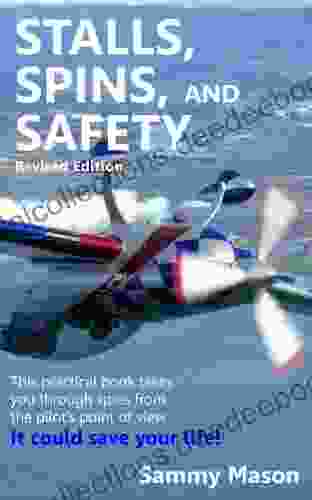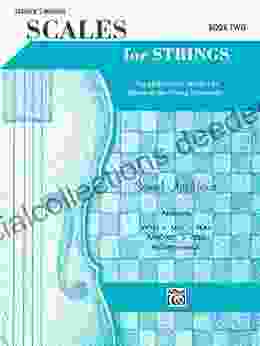Stalls, Spins, and Safety Revised Edition: A Comprehensive Guide to Preventing and Recovering from In-Flight Emergencies

Stalls and spins are two of the most dangerous situations that a pilot can encounter. A stall occurs when an aircraft loses lift and begins to descend rapidly. A spin occurs when an aircraft enters a downward spiral, rotating around its vertical axis. Both stalls and spins can be fatal if not recovered from quickly.
4.4 out of 5
| Language | : | English |
| File size | : | 3784 KB |
| Text-to-Speech | : | Enabled |
| Screen Reader | : | Supported |
| Enhanced typesetting | : | Enabled |
| Print length | : | 165 pages |
| Lending | : | Enabled |
The good news is that stalls and spins are preventable. By understanding the causes of these emergencies and by practicing the proper recovery techniques, pilots can greatly reduce their risk of being involved in a fatal accident.
Causes of Stalls
Stalls occur when the wings of an aircraft are no longer able to generate enough lift to keep the aircraft in the air. This can happen for a number of reasons, including:
- Too slow airspeed: The most common cause of stalls is flying too slowly. When an aircraft flies too slowly, the wings do not have enough air flowing over them to generate enough lift. This can happen during takeoff, landing, or when the aircraft is in a turn.
- Too high angle of attack: The angle of attack is the angle between the wings of the aircraft and the oncoming air. When the angle of attack is too high, the air flowing over the wings becomes turbulent and the wings lose lift. This can happen when the aircraft is climbing too steeply or when it is in a turn.
- Icing: Ice can build up on the wings of an aircraft, which can reduce the amount of lift that the wings can generate. This can lead to a stall if the ice buildup is severe enough.
- Weight and balance: The weight and balance of an aircraft can affect its stall speed. If an aircraft is overweight or if the weight is not distributed evenly, the stall speed will be higher.
Causes of Spins
Spins occur when an aircraft enters a downward spiral, rotating around its vertical axis. This can happen for a number of reasons, including:
- Uncoordinated flight: The most common cause of spins is uncoordinated flight. This occurs when the aircraft is not flying smoothly and the controls are not coordinated. This can happen when the pilot is making sudden or jerky movements with the controls, or when the aircraft is flying in turbulence.
- Stall: A stall can lead to a spin if the pilot does not recover from the stall quickly enough. When an aircraft stalls, it loses lift and begins to descend rapidly. This can cause the aircraft to enter a spin if the pilot does not take corrective action.
- Asymmetric lift: Asymmetric lift occurs when one wing of an aircraft generates more lift than the other wing. This can happen when the aircraft is flying in a crosswind or when one wing is iced over. Asymmetric lift can cause the aircraft to enter a spin if the pilot does not take corrective action.
Preventing Stalls and Spins
The best way to prevent stalls and spins is to avoid the situations that can lead to these emergencies. Here are some tips for preventing stalls and spins:
- Maintain a safe airspeed: The most important thing you can do to prevent a stall is to maintain a safe airspeed. The safe airspeed for your aircraft will vary depending on the weight and balance of the aircraft, as well as the conditions in which you are flying. However, as a general rule of thumb, you should never fly below the stall speed of your aircraft.
- Avoid high angles of attack: Another way to prevent stalls is to avoid high angles of attack. The higher the angle of attack, the less lift the wings will generate. This is especially important during takeoff, landing, and when the aircraft is in a turn.
- Be aware of icing conditions: If you are flying in icing conditions, be sure to take steps to prevent ice from building up on the wings of your aircraft. This may involve using anti-ice or de-icing equipment.
- Properly distribute weight and balance: The weight and balance of your aircraft can affect its stall speed. Be sure to properly distribute weight and balance before each flight.
- Practice coordinated flight: One of the best ways to prevent spins is to practice coordinated flight. This means flying smoothly and making sure that the controls are coordinated. You should practice coordinated flight in all flight conditions, including turbulence.
Recovering from Stalls and Spins
If you do find yourself in a stall or spin, it is important to remain calm and take the following steps:
Recovering from a Stall
- Reduce the angle of attack: The first step to recovering from a stall is to reduce the angle of attack. This can be done by pushing the control yoke forward or by pulling back on the elevator. As the angle of attack is reduced, the wings will begin to generate more lift and the aircraft will start to climb.
- Increase power: Once the angle of attack has been reduced, you can increase power to help the aircraft climb. Be careful not to increase power too quickly, as this could cause the aircraft to stall again.
Recovering from a Spin
- Stop the spin: The first step to recovering from a spin is to stop the spin. This can be done by applying opposite rudder and aileron inputs. The rudder will help to stop the aircraft from rotating, while the ailerons will help to level the wings.
- Reduce the angle of attack: Once the spin has been stopped, you can reduce the angle of attack. This can be done by pushing the control yoke forward or by pulling back on the elevator. As the angle of attack is reduced, the wings will begin to generate more lift and the aircraft will start to climb.
- Increase power: Once the angle of attack has been reduced, you can increase power to help the aircraft climb. Be careful not to increase power too quickly, as this could cause the aircraft to stall again.
Stalls and spins are two of the most dangerous situations that a pilot can encounter. However, by understanding the causes of these emergencies and by practicing the proper recovery techniques, pilots can greatly reduce their risk of being involved in a fatal accident.
If you are a pilot, I encourage you to take the time to read this article and to practice the recovery techniques described in it. By ng so, you can help to ensure your safety and the safety of your passengers.
4.4 out of 5
| Language | : | English |
| File size | : | 3784 KB |
| Text-to-Speech | : | Enabled |
| Screen Reader | : | Supported |
| Enhanced typesetting | : | Enabled |
| Print length | : | 165 pages |
| Lending | : | Enabled |
Do you want to contribute by writing guest posts on this blog?
Please contact us and send us a resume of previous articles that you have written.
 Book
Book Novel
Novel Page
Page Chapter
Chapter Story
Story Genre
Genre Reader
Reader Library
Library Paperback
Paperback E-book
E-book Magazine
Magazine Paragraph
Paragraph Shelf
Shelf Glossary
Glossary Preface
Preface Manuscript
Manuscript Codex
Codex Bestseller
Bestseller Library card
Library card Biography
Biography Memoir
Memoir Encyclopedia
Encyclopedia Dictionary
Dictionary Thesaurus
Thesaurus Catalog
Catalog Borrowing
Borrowing Stacks
Stacks Study
Study Research
Research Scholarly
Scholarly Reserve
Reserve Academic
Academic Journals
Journals Reading Room
Reading Room Thesis
Thesis Storytelling
Storytelling Awards
Awards Reading List
Reading List Book Club
Book Club Textbooks
Textbooks Lee Kochenderfer
Lee Kochenderfer Michael Vannoy Adams
Michael Vannoy Adams Emanuel Deutschmann
Emanuel Deutschmann Eat Like A Local
Eat Like A Local Erosa Knowles
Erosa Knowles Rob Ansell
Rob Ansell Wm Earle Wheeler
Wm Earle Wheeler David Swanson
David Swanson Rick Partlow
Rick Partlow Lily E Hirsch
Lily E Hirsch Dr Chikezie Kenneth Nwagu
Dr Chikezie Kenneth Nwagu Jocelyn Soriano
Jocelyn Soriano James Taylor
James Taylor Hannah Webster Foster
Hannah Webster Foster Clay Mcleod Chapman
Clay Mcleod Chapman James Hobson
James Hobson Rand Paul
Rand Paul Jamie Davis
Jamie Davis Andrew Mark Herman
Andrew Mark Herman Joseph M Siracusa
Joseph M Siracusa
Light bulbAdvertise smarter! Our strategic ad space ensures maximum exposure. Reserve your spot today!
 Ernest ClineFollow ·13.3k
Ernest ClineFollow ·13.3k Emanuel BellFollow ·12.6k
Emanuel BellFollow ·12.6k Roberto BolañoFollow ·15.5k
Roberto BolañoFollow ·15.5k Al FosterFollow ·3.9k
Al FosterFollow ·3.9k Jack ButlerFollow ·3.5k
Jack ButlerFollow ·3.5k Beau CarterFollow ·2.6k
Beau CarterFollow ·2.6k Eddie BellFollow ·9.2k
Eddie BellFollow ·9.2k Robert FrostFollow ·5k
Robert FrostFollow ·5k

 Andy Hayes
Andy HayesEmbracing Now: Embark on a Mindfulness Journey for a...
In a world...

 Heath Powell
Heath Powell100 Hymns for Violin and Guitar: A Comprehensive Guide to...
The violin and...

 Floyd Richardson
Floyd RichardsonBark In The Park: Poems For Dog Lovers
Dogs are our best...

 Douglas Adams
Douglas AdamsThe Barter Crusade: A Journey into the Realm of Exchange...
In a world driven by monetary transactions,...

 Nathaniel Hawthorne
Nathaniel HawthorneInsight Guides Explore Nice & the French Riviera...
Prepare to embark on an unforgettable journey...

 Carlos Fuentes
Carlos FuentesThe Ultimate Practical Guide to Percussion: Exploring the...
Embark on a journey into the enchanting...
4.4 out of 5
| Language | : | English |
| File size | : | 3784 KB |
| Text-to-Speech | : | Enabled |
| Screen Reader | : | Supported |
| Enhanced typesetting | : | Enabled |
| Print length | : | 165 pages |
| Lending | : | Enabled |












